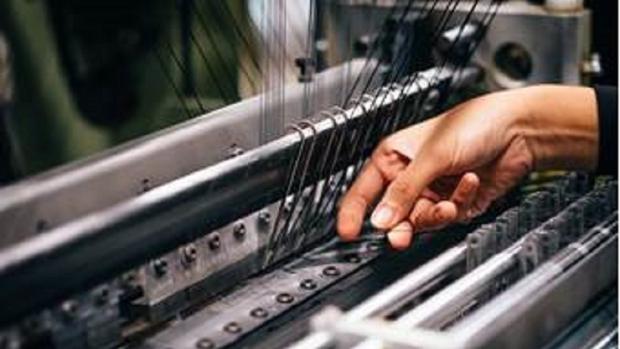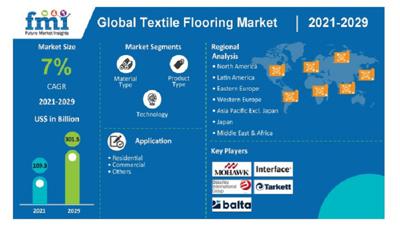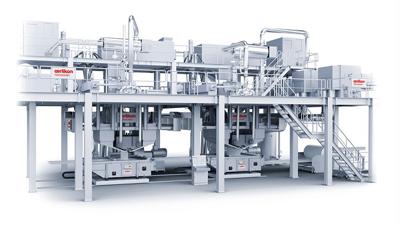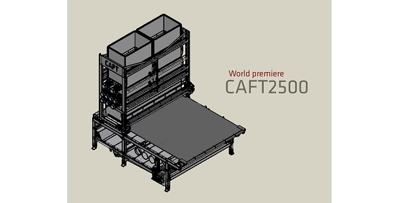Future Market Insight

(Source: Future Market Insights)
Global demand for the airlaid textile market is expected to reach a market valuation of US$ 0.5 billion by the end of 2023, accelerating at a CAGR of 5.5% over the forecast period (2023 to 2033). Airlaid textiles are a class of organic compounds that contain a ketone functional group within a cyclic structure. They have a wide range of applications in various industries, including pharmaceuticals, flavors and fragrances, and polymer production. These insights are based on the report “USA and Canada Alumina Market Outlook (2022 to 2032)” by Future Market Insights Inc., Dubai/UAE.
Some examples of airlaid textiles include cyclopentanone, cyclohexanone, and cycloheptanone. These compounds are commonly used as intermediates in the synthesis of various chemicals, such as solvents, resins, and plasticizers. They are also used as flavor and fragrance ingredients in the food and cosmetic industries.
The demand for airlaid textiles is expected to grow in the coming years due to the increasing demand for their applications in the pharmaceutical and polymer industries. Factors such as rising population and urbanization, increasing healthcare expenditure, and growing demand for eco-friendly polymers are expected to drive the growth of the airlaid textile market.
The Asia Pacific region is one of the fastest-growing markets for airlaid textiles, driven by several factors such as increasing population, rising disposable incomes, and growing demand for hygiene products.
Countries such as China, India, Japan, and South Korea are among the largest markets for airlaid textiles in the region. In China, for example, there is a growing demand for hygiene products such as diapers and feminine hygiene products, which are major applications of airlaid textiles. India is also a growing market for airlaid textiles, driven by increasing demand for hygiene products, medical products, and industrial wipes.
In addition to hygiene products, there is also growing demand for airlaid textiles in other applications such as automotive and construction materials. As the region's economies continue to grow, there is increasing demand for high-quality and innovative materials in a wide range of industries.
The North America region is a significant market for airlaid textiles, driven by several factors such as the presence of established players, growing demand for eco-friendly and sustainable materials, and increasing use of nonwovens in various applications.
The USA is the largest market for airlaid textiles in the region, accounting for a significant share of the market. The country is a major producer of hygiene products, including diapers, feminine hygiene products, and adult incontinence products, which are major applications of airlaid textiles. Furthermore, there is also growing demand for airlaid textiles in the production of medical products, food packaging, and industrial wipes.
Canada is also a growing market for airlaid textiles, driven by increasing demand for hygiene products, medical products, and other applications of airlaid textiles.
Some examples of airlaid textiles include cyclopentanone, cyclohexanone, and cycloheptanone. These compounds are commonly used as intermediates in the synthesis of various chemicals, such as solvents, resins, and plasticizers. They are also used as flavor and fragrance ingredients in the food and cosmetic industries.
The demand for airlaid textiles is expected to grow in the coming years due to the increasing demand for their applications in the pharmaceutical and polymer industries. Factors such as rising population and urbanization, increasing healthcare expenditure, and growing demand for eco-friendly polymers are expected to drive the growth of the airlaid textile market.
The Asia Pacific region is one of the fastest-growing markets for airlaid textiles, driven by several factors such as increasing population, rising disposable incomes, and growing demand for hygiene products.
Countries such as China, India, Japan, and South Korea are among the largest markets for airlaid textiles in the region. In China, for example, there is a growing demand for hygiene products such as diapers and feminine hygiene products, which are major applications of airlaid textiles. India is also a growing market for airlaid textiles, driven by increasing demand for hygiene products, medical products, and industrial wipes.
In addition to hygiene products, there is also growing demand for airlaid textiles in other applications such as automotive and construction materials. As the region's economies continue to grow, there is increasing demand for high-quality and innovative materials in a wide range of industries.
The North America region is a significant market for airlaid textiles, driven by several factors such as the presence of established players, growing demand for eco-friendly and sustainable materials, and increasing use of nonwovens in various applications.
The USA is the largest market for airlaid textiles in the region, accounting for a significant share of the market. The country is a major producer of hygiene products, including diapers, feminine hygiene products, and adult incontinence products, which are major applications of airlaid textiles. Furthermore, there is also growing demand for airlaid textiles in the production of medical products, food packaging, and industrial wipes.
Canada is also a growing market for airlaid textiles, driven by increasing demand for hygiene products, medical products, and other applications of airlaid textiles.
Demand drivers
There is high demand for airlaid textile in developed countries for feminine hygiene and adult incontinence products, combined with rapid population aging and growing spending on elderly care. The adoption of feminine hygiene products in developing countries has grown by leaps and bounds in the wake of dedicated campaigns by civil society and government departments.
The improved access to sanitation products for the female population in developing countries, particularly in rural areas has contributed to substantial growth in the market.
Strong demand for wipes and food pads, improving economic conditions, sophisticated cultural preferences, and high use of hygiene products are the factors driving the airlaid market growth.
Personal care products
Wipes are an efficient carrier for cost-effective application of a wide range of active ingredients. A wet, disposable cloth used for cleaning surfaces, but also an antiseptic fabric for skin cleaning, the wipes market consists of sales of wipes and related services used in the personal, industrial sectors and household application.
The growing usage of these products has had a positive impact on the demand for airlaid textiles. In the wake of the Covid-19 pandemic there is an increased focus on maintaining personal hygiene and cleanliness. Such factor will further contribute to the demand for personal hygiene and care products thus enabling market growth.
The USA and Canada airlaid textile market outlook
The USA is one of the most prominent markets, with strong domestic demand for personal as well as industrial applications. Although the restrictions relating to the pandemic did have a significant impact on the overall supply chain of the market, demand witnessed only a marginal impact. Demand is expected to rebound fully by the second quarter of 2021 as the country eases previous restrictions on the movement of people and goods.
The textile industry in the USA is a supplier to 3 major industrial end-use sectors: apparel, floor coverings, and home textiles, as well as technical textiles used in manufactured industrial production.
The USA airlaid textile sales will also be impacted by the industrial sector recovery in 2021. The USA Industrial sector faces various challenges, however, there is growing optimism that a successful nationwide vaccination drive will ensure the economy opens up sooner rather than later, helping boost demand.
Europe demand outlook for airlaid textiles
Most of the countries in the EU have been severely impacted by the Covid-19 crisis, which has led to a decline in economic activities. Restrictions on mobility, a drop in personal incomes, and a weak industrial sector had strong repercussions on the overall state of the economies.
However, demand for personal sanitation and hygiene products managed to hold its own to some extent. Supply-side restrictions did exert additional strain on the overall balance of the market. However, the gradual resumption of factories in East Asia in the second half of 2020 eased the supply constraints. The market in Europe is forecast to continue on an upward growth trend during the forecast period.



